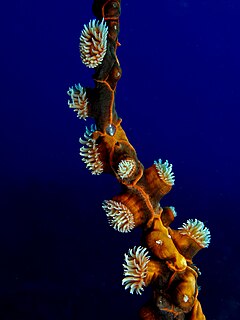| Isotealia | |
|---|---|
| Scientific classification | |
| Kingdom: | Animalia |
| Phylum: | Cnidaria |
| Class: | Anthozoa |
| Order: | Actiniaria |
| Family: | Actiniidae |
| Genus: | Isotealia Carlgren, 1899 |
Isotealia is a genus of sea anemones in the family Actiniidae.
| Isotealia | |
|---|---|
| Scientific classification | |
| Kingdom: | Animalia |
| Phylum: | Cnidaria |
| Class: | Anthozoa |
| Order: | Actiniaria |
| Family: | Actiniidae |
| Genus: | Isotealia Carlgren, 1899 |
Isotealia is a genus of sea anemones in the family Actiniidae.
The World Register of Marine Species includes the following species in the genus:- [1]

Tube-dwelling anemones or ceriantharians look very similar to sea anemones but belong to an entirely different subclass of anthozoans. They are solitary, living buried in soft sediments. Tube anemones live inside and can withdraw into tubes, which are composed of a fibrous material made from secreted mucus and threads of nematocyst-like organelles known as ptychocysts. Within the tubes of these ceriantharians, more than one polyp is present, which is an exceptional trait because species that create tube systems usually contain only one polyp per tube. Ceriantharians were formerly classified in the taxon Ceriantipatharia along with the black corals but have since been moved to their own subclass, Ceriantharia.

Zoanthids are an order of cnidarians commonly found in coral reefs, the deep sea and many other marine environments around the world. These animals come in a variety of different colonizing formations and in numerous colors. They can be found as individual polyps, attached by a fleshy stolon or a mat that can be created from small pieces of sediment, sand and rock. The term "zoanthid" refers to all animals within this order Zoantharia, and should not be confused with "Zoanthus", which is one genus within Zoantharia.

Corallimorpharia is an order of marine cnidarians closely related to stony or reef building corals (Scleractinia). They occur in both temperate and tropical climates, although they are mostly tropical. Temperate forms tend to be very robust, with wide and long columns, whereas tropical forms tend to have very short columns with a wide oral disc and very short tentacles. The tentacles are usually arranged in rows radiating from the mouth. Many species occur together in large groups, although there are recorded instances of individuals. In many respects, they resemble the stony corals, except for the absence of a stony skeleton. Morphological and molecular evidence suggests that they are very closely related to stony corals.

Amphianthus is a genus of sea anemones. It is the only genus in the monotypic family Amphianthidae.

Bunodosoma is a genus of sea anemones in the family Actiniidae.

Bunodactis is a genus of sea anemones in the family Actiniidae.

Epiactis is a genus of sea anemones in the family Actiniidae. There are about nineteen recognised species and the type species is Epiactis prolifera.

Peachia is a genus of sea anemone in the family Haloclavidae. Members of this genus typically burrow into soft substrates. The only part of the animal that is normally visible is the oral disc and tentacles which lie flat on the sand in a star shape. The type species is Peachia cylindrica.

Cerianthus is a genus of tube-dwelling anemones in the family Cerianthidae. Members of the genus are found worldwide. They are predators, scavengers and omnivores.

Sagartiogeton is a genus of sea anemones in the family Sagartiidae.
Ceriantheomorphe is a genus of tube-dwelling anemones in the family Cerianthidae.

Arachnanthus is a genus of tube-dwelling anemones in the family Arachnactidae. Members of the genus are found worldwide.

Actinostolidae is a family of sea anemones in the order Actiniaria. Members of this family are deep sea species, with some occurring at hydrothermal vents.

Actinostola is a genus of sea anemones in the order Actiniaria. All members of this genus are deep-sea species, with some occurring at hydrothermal vents.

Diadumene is a genus of sea anemones. It is the only genus in the monotypic family Diadumenidae.

Haloclava is a genus of sea anemones in the family Haloclavidae. Members of this genus typically burrow into soft sediment.
Paranthus is a genus of sea anemones in the family Actinostolidae.

Pachycerianthus is a genus of marine tube-dwelling anemones in the family Cerianthidae.

Boloceroides is a genus of sea anemones in the family Boloceroididae. It contains the following species:
Isotealia antarctica, the salmon anemone, is a species of sea anemone in the family Actiniidae. It is found in the southern Atlantic and Pacific Oceans and the waters around Antarctica. It is a filter feeder and opportunistic predator.